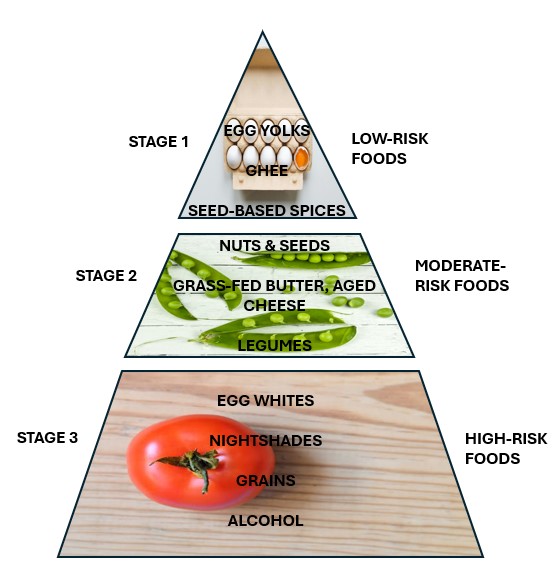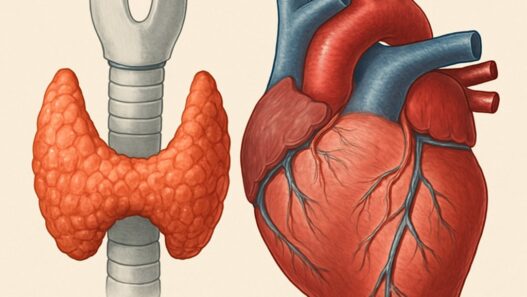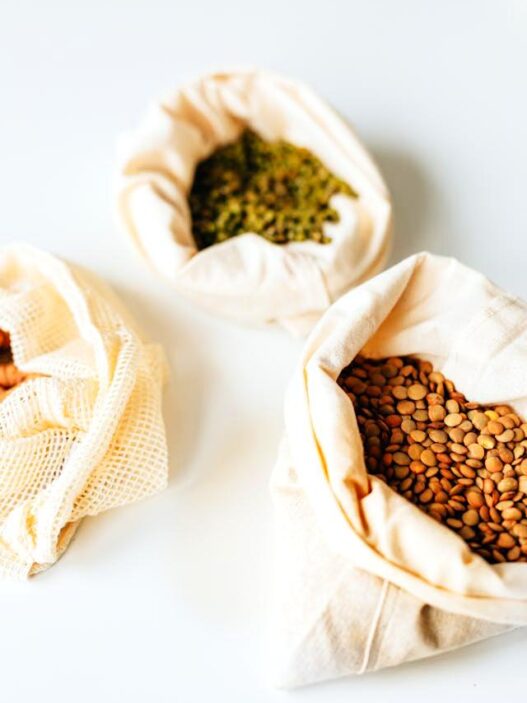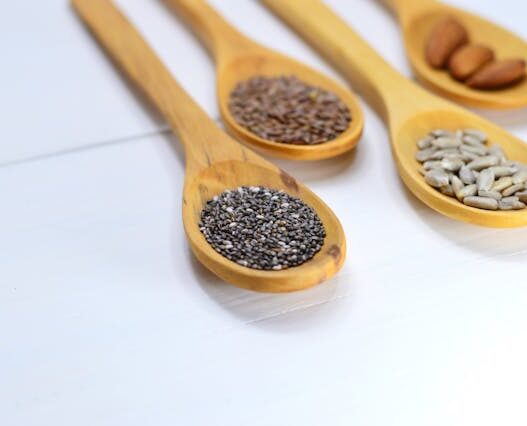
The Stages of AIP Reintroduction Phase: A Comprehensive Guide to Reintroducing Foods After the Elimination Phase
The Stages of AIP Reintroduction phase come after completing the elimination phase of the Autoimmune Protocol (AIP). You’ve successfully removed foods that may trigger inflammation, immune responses, or digestive issues. Now comes the critical phase of reintroducing foods—and it’s a phase that requires patience, awareness, and careful observation. The goal of reintroduction is to identify which foods can be tolerated and which ones may need to be avoided long-term. This process is essential for crafting a sustainable, personalized diet that supports healing and minimizes flare-ups.
Reintroducing foods on the Autoimmune Protocol (AIP) diet is a pivotal step in understanding your unique triggers while slowly expanding your diet. The process should be approached systematically to maximize its benefits. Here’s an extensive guide to the three stages of AIP reintroduction, tailored for a thoughtful, personalized approach.
In this post, we will walk you through the stages of food reintroduction, the symptoms to monitor, and the steps to take if you experience a reaction to any reintroduced food.
Why Reintroduction Matters
The elimination phase of AIP is designed to calm inflammation and heal your gut by removing potential triggers. However, staying in the elimination phase indefinitely is not the goal. Reintroducing foods:
- Identifies personal triggers.
- Expands dietary diversity, which supports gut health and overall well-being.
- Helps you create a sustainable long-term diet.
Tracking Symptoms During Reintroduction
- Keep a Food Journal:
- Record the food, portion size, and any symptoms you experience over the next 3–7 days.
- Include notes on mood, energy levels, and digestion.
- Be Patient:
- Avoid testing more than one new food at a time to ensure clear results.
- Wait for any reactions to subside before introducing the next food.
- Symptoms to Look For:
- Physical: Fatigue, bloating, joint pain, or headaches.
- Emotional: Mood swings, irritability, or anxiety.
- Autoimmune: Worsening of pre-existing symptoms such as skin rashes or digestive issues.
| Symptom Category | Symptoms to Look For |
| Digestive Issues | Bloating, gas, diarrhea, constipation, acid reflux, stomach cramps, nausea |
| Skin Changes | Rashes, hives, eczema, acne, itching, dryness |
| Energy Levels | Fatigue, brain fog, difficulty concentrating |
| Joint Pain | Stiffness, swelling, or increased pain in joints |
| Respiratory Issues | Nasal congestion, sneezing, coughing, difficulty breathing |
| Mental Health Changes | Anxiety, irritability, mood swings, restlessness |
| Systemic Inflammation | Swelling in hands or feet, fever, generalized discomfort |
| Autoimmune Flare-Ups | Worsening of pre-existing autoimmune symptoms, such as digestive distress, joint pain, or skin flare-ups |
How to Use This Table
- Monitor Closely: Use the table as a checklist while observing your body after reintroducing a food.
- Log Symptoms: Record any of the above symptoms in your food journal, noting the timing and intensity.
- Pause if Necessary: If a symptom appears, stop reintroducing the food and give your body time to recover.
If you experience any of the symptoms listed during the AIP reintroduction phase, here’s a step-by-step guide on what to do:
Step 1: Stop Consuming the Food
- Immediately discontinue the food you are testing. Even a small amount can cause ongoing reactions if it is not well tolerated.
- Do not try to “push through” symptoms to see if they improve.
Step 2: Record the Reaction
- Food Journal: Write down the food, portion size, and all symptoms you experienced.
- Note when the symptoms started and their duration to help identify patterns in future reintroductions.
Step 3: Manage the Symptoms
The steps to alleviate symptoms depend on the type:
| Symptom Category | What to Do |
|---|---|
| Digestive Issues | Drink warm water or herbal teas (e.g., ginger, peppermint) to soothe the stomach. Avoid irritants like caffeine or alcohol. |
| Skin Changes | Use soothing, natural moisturizers like aloe vera or coconut oil. For itching, try antihistamines if necessary. |
| Energy Levels | Rest and focus on hydration. Reduce activities that require intense focus. |
| Joint Pain | Apply cold or warm compresses to affected areas. Consider natural anti-inflammatories like turmeric. |
| Respiratory Issues | Use a saline nasal spray for congestion or steam inhalation to ease breathing. If severe, consult a doctor. |
| Mental Health Changes | Practice relaxation techniques like deep breathing or meditation. Limit stress triggers. |
| Systemic Inflammation | Rest, hydrate, and consume anti-inflammatory foods like bone broth or turmeric tea. |
| Autoimmune Flare-Ups | Revert to strict elimination phase foods and avoid known inflammatory triggers. Allow time to heal. |
Step 4: Wait and Observe
- Give your body time to recover before testing another food.
- Wait at least 3–7 days after symptoms subside to allow inflammation or sensitivity to resolve.
Step 5: Re-Evaluate the Food
- Decide whether to reintroduce the food later. Some foods may not be tolerated now but could be reintroduced successfully after more gut healing.
- Use smaller portions or different preparation methods (e.g., boiling instead of frying) for potentially better tolerance.
When to Seek Medical Advice
Contact a healthcare provider if you experience:
- Severe symptoms, such as difficulty breathing, intense abdominal pain, or high fever.
- Persistent symptoms that don’t improve within a week.
- Signs of an autoimmune flare that significantly impacts your daily life.
Tips for Success
- Start Small: Always introduce foods in tiny amounts (e.g., a teaspoon or single bite).
- Revisit Foods Later: If a food causes symptoms, it may not always be off-limits. Revisit it after additional gut healing.
- Focus on Variety: Diversity in your diet supports gut microbiota and long-term health.
- Listen to Your Body: Your experience is the best guide—use these stages as a framework, but adapt them to your needs.
Symptoms during reintroduction don’t mean a food is permanently off-limits. Each body is unique, and tolerances can improve over time. Stay patient, track your progress, and remember that the AIP journey is about finding what works best for you.
The Three Stages of Reintroduction
Stage 1: Low-Risk Foods (Start Here)
Begin with foods that are highly nutrient-dense and have the lowest potential for causing reactions. These foods allow you to ease into reintroduction without significant risk.
Examples of Foods:
- Egg Yolks: Nutrient-packed and less allergenic than egg whites.
- Ghee: A clarified butter with most milk proteins removed.
- Seed-Based Spices: Cumin, coriander, fennel, and others.
- Fermented Foods: Coconut yogurt or sauerkraut (if previously eliminated).
Symptoms to Monitor:
- Digestive Issues: Bloating, diarrhea, gas, or stomach cramps.
- Skin Changes: Rashes, hives, or acne.
- Energy Levels: Fatigue, brain fog, or difficulty concentrating.
- Joint Pain: Any increase in stiffness or swelling.
How to Reintroduce:
- Start with a small amount (e.g., a teaspoon of ghee or half an egg yolk).
- Monitor symptoms over 3–7 days before increasing the quantity or introducing a new food.
Stage 2: Moderate-Risk Foods
Once you’ve successfully reintroduced several Stage 1 foods, proceed to those with a slightly higher likelihood of causing reactions.
Examples of Foods:
- Nuts and Seeds: Almonds, walnuts, sunflower seeds (raw or roasted).
- Certain Dairy Products: Grass-fed butter, aged cheeses (e.g., Parmesan).
- Legumes: Green beans, lentils, or chickpeas (cooked thoroughly).
Symptoms to Monitor:
- Respiratory Issues: Nasal congestion, sneezing, or difficulty breathing.
- Mental Health Changes: Anxiety, mood swings, or irritability.
- Autoimmune Flare-Ups: Any worsening of pre-existing autoimmune symptoms.
How to Reintroduce:
- Begin with a very small portion, such as one almond or a tablespoon of lentils.
- Gradually increase the serving size over several days if no adverse reactions occur.
Stage 3: High-Risk Foods (Final Phase)
Foods in this category are the most likely to cause inflammatory responses. Introduce them cautiously and only after successfully testing lower-risk foods.
Examples of Foods:
- Egg Whites: Introduced separately from yolks due to their allergenic proteins.
- Nightshades: Tomatoes, eggplants, peppers, and potatoes.
- Grains: White rice or gluten-free oats.
- Alcohol: A small amount of wine or distilled spirits.
Symptoms to Monitor:
- Gastrointestinal Reactions: Nausea, acid reflux, or constipation.
- Skin Sensitivity: Eczema flare-ups or itching.
- Systemic Inflammation: Swelling, fever, or general discomfort.
How to Reintroduce:
- Opt for the least processed version of each food. For example, try fresh tomatoes instead of canned.
- Be particularly vigilant for symptoms, as these foods are more likely to be problematic.
Why Foods Should Be Introduced One by One
- Individual Reactions: Different foods, even within the same category (like legumes or nightshades), can have unique effects on your body. For example:
- Chickpeas might be well-tolerated, but lentils or beans may still trigger reactions due to their unique composition.
- Nightshades like tomatoes may cause issues, but other members of the group (like peppers or eggplants) may not.
- Food-Specific Sensitivities: Foods within a similar group may contain different compounds or levels of problematic substances (like lectins in beans vs. lentils) that affect different people in various ways.
- Gradual Observation: When reintroducing foods, you need to be able to track symptoms and determine which specific food is causing any adverse reactions. This is more difficult if you reintroduce multiple foods at once. If a reaction occurs, it’s crucial to pinpoint the exact trigger.
How to Reintroduce Foods from the Same Category
- Choose One Food: From each stage, pick one food to reintroduce. For instance:
- While you are in Stage 1, you might start with ghee before moving to seed-based spices.
- Moving to Stage 2, start with green beans before testing peas or lentils.
- In Stage 3, reintroduce coffee before testing chocolate or cocoa.
- Monitor for Symptoms: Track symptoms for 3–7 days. This period gives your body enough time to react to the food and provides insight into how well it’s tolerated.
- Record any changes in digestion, skin, mood, joint pain, or energy.
- Be mindful of subtle symptoms (e.g., slight bloating or mood shifts) that could indicate intolerance.
- If No Reaction, Move to the Next Food: If the first food is well-tolerated, you can gradually try another food within the same stage.
- Continue monitoring symptoms to ensure that no issues arise with the new food.
- Keep in mind that just because one food in the group is tolerated doesn’t mean the next one will be.
- If a Reaction Occurs, Wait and Try Again Later: If you experience symptoms, stop the reintroduction of the current food and wait for the reaction to subside.
- You can wait for symptoms to clear before trying again.
- Reintroduce the food at a smaller amount or with a different preparation method (e.g., cooked vs. raw).
Example of Reintroducing Legumes
For example, if you’re reintroducing legumes, follow this process carefully:
- Stage 2: Start with green beans first.
- If green beans are well tolerated, you can then move on to peas or lentils after waiting the necessary 3-7 days and monitoring your body’s response.
- If green beans cause a reaction, you may choose to skip or avoid all legumes with edible pods for now, and possibly retry later.
- You would not introduce chickpeas, beans, or lentils all at once in Stage 2 because you need to know which specific legume caused the issue.
Green beans and legumes with edible pods (such as sugar snap peas and snow peas) are generally reintroduced in Stage 2 of the AIP reintroduction process. Here’s why and how to approach them:
Why Stage 2?
- Lower Lectin Content: Unlike dried legumes (e.g., lentils, chickpeas), green beans and other legumes with edible pods have a lower concentration of lectins and other compounds that can irritate the gut.
- Better Digestibility: These legumes are consumed in their fresh or immature form, making them less likely to trigger autoimmune reactions compared to dried or processed legumes.
How to Reintroduce Green Beans and Edible Pod Legumes
- Start Small: Begin with a few bites of cooked green beans or sugar snap peas. Cooking reduces lectins and increases digestibility.
- Monitor Symptoms: Observe your body for any signs of digestive distress, joint pain, fatigue, or other symptoms for 3–7 days.
- Gradually Increase: If no adverse reactions occur, increase the portion size gradually over several days.
Symptoms to Monitor
- Digestive: Gas, bloating, stomach cramps.
- Joint/Muscle: Stiffness or swelling.
- Skin: Rashes, itching, or acne.
- Energy: Fatigue, brain fog.
Cocoa and Chocolate
Why Stage 3?
- Phytates and Oxalates: Cocoa contains anti-nutrients that may irritate the gut in sensitive individuals.
- Stimulants: Theobromine and caffeine in cocoa can affect adrenal health and energy regulation.
- Additives: Most chocolates contain sugar, dairy, or other ingredients not AIP-compliant.
How to Reintroduce Cocoa/Chocolate:
- Choose AIP-Compliant Options: Use 100% cocoa powder or unsweetened, dairy-free chocolate (e.g., pure cacao).
- Start Small: Begin with a teaspoon of cocoa powder or a small piece of chocolate.
- Monitor Symptoms: Look for digestive upset (e.g., bloating), skin changes (e.g., rashes), or mood fluctuations.
- Gradually Increase: If tolerated, you can experiment with larger portions.
Coffee
Why Stage 3?
- Caffeine Content: Coffee’s caffeine can overstimulate the nervous system, affect sleep, and increase cortisol, which may exacerbate autoimmune symptoms.
- Cross-Reactivity: Some individuals with gluten sensitivity may react to proteins in coffee due to molecular mimicry.
- Acidity: Coffee is acidic, which may irritate the gut lining or exacerbate autoimmune gastritis.
How to Reintroduce Coffee:
- Start with Decaf: Test decaffeinated coffee first to assess tolerance without the stimulant effect.
- Choose Quality: Use organic coffee to minimize exposure to pesticides.
- Start Small: Begin with a half cup or less and drink it black or with approved AIP milk (e.g., coconut milk).
- Monitor Symptoms: Watch for digestive issues (e.g., acid reflux), sleep disturbances, or mood changes.
Symptoms to Watch for with Cocoa and Coffee
| Symptom Category | Specific Symptoms |
|---|---|
| Digestive Issues | Bloating, diarrhea, stomach cramps, acid reflux |
| Energy Levels | Fatigue, jitteriness, difficulty sleeping, or energy crashes |
| Skin Changes | Rashes, hives, or acne |
| Mental Health Changes | Anxiety, irritability, mood swings |
| Autoimmune Flare-Ups | Increased joint pain, muscle stiffness, or exacerbation of pre-existing autoimmune symptoms |
Notes on Reintroduction
- Cocoa and Chocolate: If cocoa powder is tolerated, try incorporating unsweetened dark chocolate with at least 85% cacao content. Avoid milk chocolates or those with added sugar.
- Coffee: If regular coffee is not tolerated, consider herbal alternatives such as chicory root or roasted dandelion tea.
The Key Takeaway
Each food is an individual test within its stage, and a positive reaction to one food does not guarantee that other foods in the same category will be fine. It’s important to introduce one food at a time, observe carefully, and wait for symptoms to resolve before proceeding to the next one.
This approach ensures you’re not inadvertently overloading your system and gives you clearer insights into how each food affects your body.
Would you like me to integrate this point into your post?




















